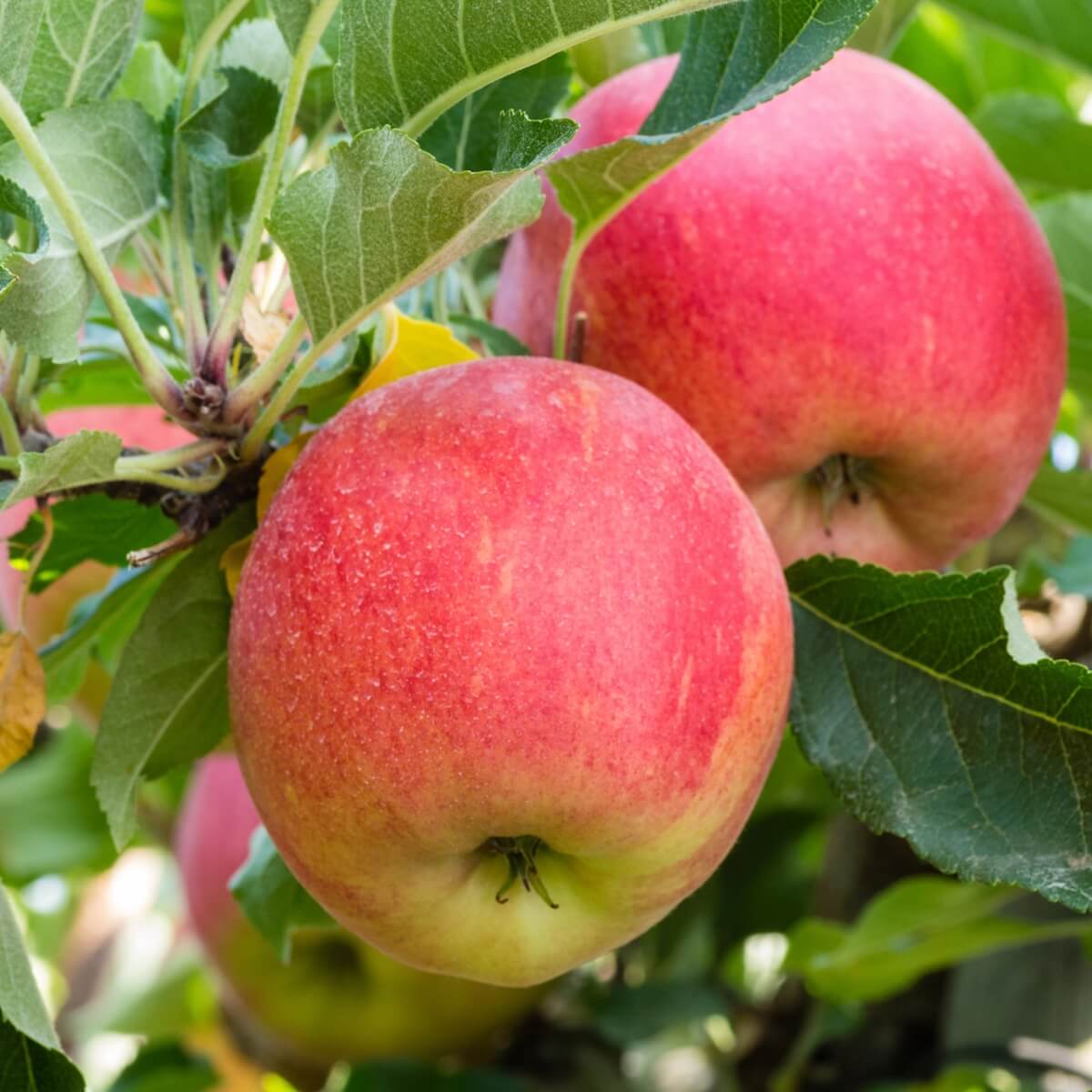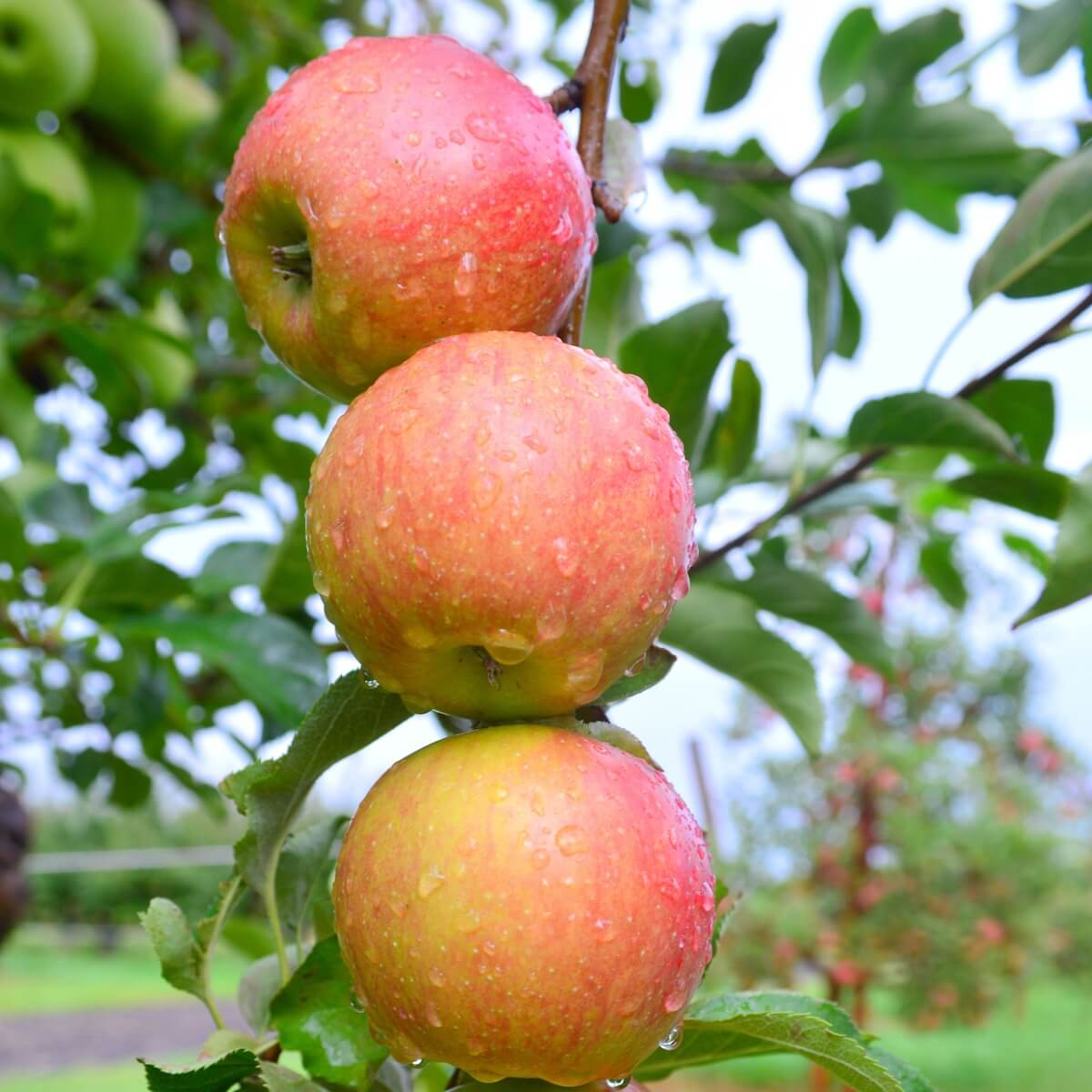
Position
- Full sun
- Sheltered from strong winds
- South or south-west facing aspect
- Protected from frost pockets
- Good air circulation is essential
Hardiness
- Hardy down to -20°C (-4°F)
- Requires winter chilling for fruit production
- Spring flowers need protection from late frosts
Soil
- Well-drained, fertile loam
- Adaptable to most soil types if drainage is good
- Avoid heavy clay or waterlogged conditions
- Prefers neutral to slightly acidic soil
- Tolerates a pH range from 6.0 to 7.0
- Grab a soil test kit and ensure the perfect conditions for growth
Height
- On M26 rootstock: 2.5-3 metres (8-10 feet)
- On M9 rootstock: 1.8-2.4 metres (6-8 feet)
Seasons of Interest
- Spring flowering: Mid to late April
- Pink-white blossom clusters
- Fruit development: July-September
- Harvest period: Mid-September to early October
- Autumn foliage: Yellow autumn colour
Additional Notes
- Partially self-fertile but produces better with a pollinator
- Requires regular pruning for best fruit production
- Popular commercial variety that grows well in home gardens
- Sweet, aromatic fruits with distinctive striped red skin
- Good storage capability (up to 6 months in proper conditions)
- Can be trained as espalier, cordon, or standard tree
- Susceptible to scab in wet conditions
- Benefits from the summer thinning of fruit
- Regular mulching is recommended
- Fruits ripen gradually, allowing extended harvest
- Good choice for beginners
- Reliable cropper in the UK climate
- Popular with children due to sweet, mild flavour
- Suitable for both cooking and eating fresh
The Ultimate Guide to Growing Apple Gala in Your Garden
Gala apples are one of the world’s most widely grown apple varieties, prized for their sweet flavour, crisp texture, and versatility. If you’re considering growing your own Gala apple tree, you’re in for a rewarding experience. This guide covers everything you need to know, from planting and pollination to harvesting and enjoying your homegrown fruit.
What Makes the Gala Apple So Popular?
Apple Gala is a supermarket favourite, thanks to its sweet, pleasant flavour and attractive appearance. Originally cultivated in New Zealand in the 1930s, it was introduced to the market in 1960 and quickly became a top choice for eating apples. The fruit is typically orange-red with a golden undertone, making it visually appealing and delicious.
How Do You Grow a Gala Apple Tree?
Growing a Gala apple tree is straightforward, even for beginners. It thrives in well-drained soil in a sheltered, sunny position. Like most apples, it benefits from a rootstock that determines its size and growth rate. M26 rootstock is ideal for smaller gardens, while MM106 supports larger trees with a strong root system.
When and Where to Plant a Gala Apple Tree?
The best time to plant apple trees is in late autumn or early spring, when the trees are dormant. Choose a sunny position with well-drained soil. Adding well-rotted manure or compost to the planting hole will improve soil structure and provide essential nutrients.

What Is the Best Pollination Partner for a Gala Apple Tree?
Gala apple trees are partially self-fertile but yield better when planted near another variety in the same pollination group. Gala belongs to group 4, so good pollinators include Cox’s Orange Pippin, Golden Delicious, and Kidd’s Orange Red. Planting two apple trees can enhance fruit production. Please check out my article here for more information on Apple pollinating groups.
How Do You Care for a Gala Apple Tree?
When Do Gala Apples Ripen?
Gala apples ripen in late summer and can be picked from the tree when they have developed their full colour and flavour. Unlike sharper varieties, Gala apples have a naturally sweet taste, making them a favourite for eating straight from the tree.
What Are the Benefits of Growing Gala Apples at Home?
Homegrown apples are fresher and tastier than supermarket apples, which often vary depending on storage conditions. A well-maintained tree can produce heavy crops year after year, providing a sustainable and delicious supply of fruit.
Are There Different Types of Gala Apples?
There are several gala sports, including the Royal Gala, a darker-skinned variety. These cultivars were selected in 1939 and have become widely grown due to their excellent flavour and attractive red colour.
How Do You Use Gala Apples?
Gala apples are perfect for eating fresh but can also be used in cooking, juicing, and making cider. Their sweet flavour makes them ideal for desserts, sauces, and salads. Organic apples from your own tree ensure a natural, chemical-free fruit supply.
From Darren’s Patch
I’ve always had a soft spot for Gala apples—they’re dependable varieties that never seem to disappoint. The Gala tree has proven to be a real workhorse in my garden: healthy, I especially love its fruit. What I especially love is how early they ripen—just when you’re craving that first bite of fresh apple after summer. Their sweetness makes them perfect for lunchboxes, and I often slice them into salads or just enjoy them straight from the tree. If you’re considering adding a fruit tree to your garden, Gala is a brilliant place to start. It’s compact enough for smaller spaces, and with the proper care and a good pollination partner nearby, you’ll be rewarded year after year with delicious, homegrown apples.
![]()
Key Points to Remember:
- Choose a sheltered, sunny position with well-drained soil
- Use a suitable rootstock such as M26 or MM106
- Plant in autumn or early spring for best results
- Water well in dry spells and mulch to prevent weeds
- Prune in winter to encourage healthy growth
- Ensure good pollination with a compatible apple variety
- Pick in late summer for the best flavour and sweetness
Growing your own Gala apple tree is a fantastic way to enjoy fresh, homegrown fruit while enhancing your garden. With the proper care, you can enjoy delicious apples year-round!
To see the RHS article, please click here.
Want to learn about other apple varieties? Read about Apple Fiesta here.
For more information on Fruit for your garden, please click here.
Frequently Asked Questions
Q: What makes the Gala apple tree popular for home orchards?
A: Apple Gala is a popular choice for home orchards because it produces sweet, pink-red dessert apples that are widely available in supermarkets. It is also relatively easy to grow, making it an excellent option for those looking to plant their own fruit trees.
Q: How does the appearance and flavour of Gala apples compare to other apple varieties?
A: Gala apples are known for their striped, reddish skin and crisp texture. They have a naturally sweet flavour with a hint of floral notes, making them juicier and more refreshing than other varieties. Their popularity has even surpassed that of Red Delicious apples!
Q: Can I grow a Gala apple tree year-round?
A: Gala apple trees cannot grow year-round in most climates, requiring a dormant winter period. They thrive in temperate climates and typically produce fruit in the autumn. However, you can enjoy Gala apples throughout the year with proper storage after harvest.
Q: What is the best soil type for planting a Gala apple tree?
A: Gala apple trees prefer well-drained soil to prevent issues such as apple scab and root rot. The best soil for them is one that retains moisture without becoming waterlogged. Adding organic matter like manure can help improve soil structure and fertility.
Q: How do I ensure good pollination for my Gala apple tree?
A: Gala apple trees benefit from cross-pollination, so it’s best to plant them near another compatible apple variety. They belong to pollination group 4, and good pollination partners include Cox’s Orange Pippin, Braeburn, or Golden Delicious.
Q: What do Gala apples taste like?
A: Gala apples have a sweet, mild flavour with subtle floral notes. Their crisp texture makes them ideal for eating fresh, baking, or adding to salads for a touch of sweetness.
Q: Is the Royal Gala different from the original Gala apple?
A: The Royal Gala is a sport (natural variation) of the original Gala apple. It typically has a darker red skin and an even sweeter taste. It was developed in New Zealand and has become a favourite among apple lovers.
Q: How big do Gala apple trees grow, and do they require a lot of space?
A: Gala apple trees can grow between 10 and 15 feet tall, though their size can be managed with pruning. They do not require much space, and compact or dwarf varieties are available for smaller gardens or container growing.
Q: When is the best time to plant a Gala apple tree?
A: The best time to plant a Gala apple tree is in autumn or early spring. If you’re planting in October, please ensure the tree has time to establish before winter. Spring planting is also an option, allowing the tree to settle in before the growing season.
Q: Where can I buy a Gala apple tree?
A: Gala apple trees are available at garden centres and online retailers specialising in fruit trees. Please look for healthy, disease-free trees from a reputable supplier to ensure the best growth and fruiting potential.
